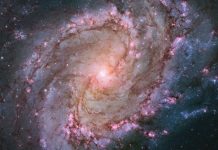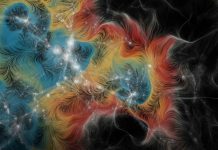
In the silent vastness of space, there’s an invisible symphony of waves constantly moving around us. These aren’t ordinary waves; they’re gravitational waves, ripples in the fabric of space itself.
Picture them as the cosmic equivalent of ripples spreading across a pond after you drop a stone into it. Scientists have been tuning into these waves, trying to catch whispers from the universe’s earliest moments.
Gravitational waves were first confirmed in 2015, a discovery that made headlines around the world. The waves detected then came from a dramatic event: the merging of two black holes, far away in space.
These waves are like loud, clear notes, momentarily changing the length of gigantic detectors on Earth designed just to listen for them.
But not all gravitational waves are so bold and distinct. Many are more like background noise, a mix of countless smaller waves coming from all directions. These are harder to spot but could tell us about the universe’s earliest days, including moments right after the Big Bang.
To find these elusive waves, scientists are using the universe itself as a giant detector, focusing on pulsars—dead stars that emit regular beams of light.
These pulsars act like cosmic lighthouses, and by measuring tiny changes in their light, we can detect the passing of gravitational waves.
Recently, a group of physicists found a new way to sift through this cosmic noise. They realized that the early universe, filled with a hot, dense soup of particles like quarks and gluons, left a unique mark on these waves.
As the universe cooled, these particles transformed in a way dictated by the laws of physics, altering the gravitational waves passing through.
This transformation, known as the “quantum chromodynamics (QCD) crossover,” happened incredibly early in the universe’s life, about a millionth of a second after the Big Bang.
During this crossover, quarks and gluons, the universe’s smallest known particles, grouped together to form the protons and neutrons that make up atoms today. This moment left a fingerprint on the gravitational waves, a signature that scientists believe they can now look for using pulsars.
The discovery is significant because it offers a new way to understand the universe’s birth. By comparing the waves from the early universe with those from later events, like black hole mergers, scientists can start to piece together a more detailed picture of cosmic history.
This research stands at the intersection of particle physics, which studies the universe’s smallest building blocks, and cosmology, which explores its grandest scales.
This finding is not just about understanding how the universe began but also about confirming the theories of physics that explain the world around us.
It shows how the universe’s most significant events and its tiniest particles are connected, offering a new clue in the ongoing quest to understand the cosmos.
The research findings can be found in Physical Review Letters.
Copyright © 2024 Knowridge Science Report. All rights reserved.



